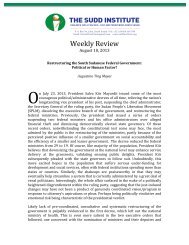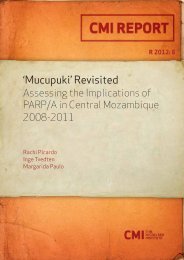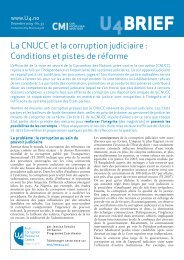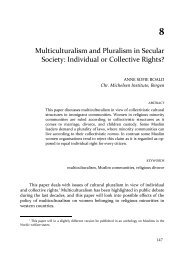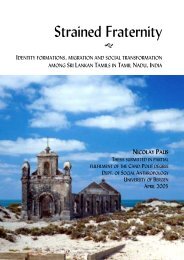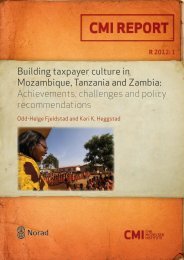Peacebuilding: Lessons for Afghanistan? - CMI
Peacebuilding: Lessons for Afghanistan? - CMI
Peacebuilding: Lessons for Afghanistan? - CMI
You also want an ePaper? Increase the reach of your titles
YUMPU automatically turns print PDFs into web optimized ePapers that Google loves.
security <strong>for</strong>ce. The alternative of deploying international <strong>for</strong>ces to protect the main<br />
highways in an interim period appears even more complicated. 19<br />
Demobilisation<br />
Any demobilisation scheme must recognise the particularities of the Afghan situation.<br />
Useful estimates of the number of fighters are not available, but much of the Afghan<br />
male population clearly has some sort of fighting experience. The war in the 1990s<br />
was not fought by large standing armies with professional soldiers. The fighting had a<br />
seasonal aspect, and the soldiers were mostly men who maintained close ties with<br />
their families and home communities, and who had an established social role as well<br />
as potential income-generating activities to return to. The rapid decline of the Taliban<br />
illustrates this point as well. Once the movement seemed unlikely to survive, its<br />
fighters and field commanders disengaged militarily to take up social roles in their<br />
communities.<br />
Conventional concepts of demobilisation and reintegration consequently have little<br />
relevance in the Afghan context. To a large extent, demobilisation can be expected to<br />
be spontaneous, and the most effective means of preventing further violence (fighting<br />
or armed crime) is to promote general economic recovery. As to the relatively small<br />
contingent of more professional soldiers, many of them would probably be absorbed<br />
in a future national security <strong>for</strong>ce.<br />
Constitutional framework<br />
Drawing up a new constitution is an essential part of the transition. Establishing<br />
principles of political representation and laying the foundation <strong>for</strong> a functioning<br />
judiciary is essential. Constitutional developments in <strong>Afghanistan</strong> date back to the<br />
early 1920s. New constitutions have often sparked political unrest, and significantly<br />
different principles have been promoted and codified. 20 The tension between<br />
minimalist and modernist positions in the international aid community, and their<br />
Afghan counterparts, is especially likely to manifest itself in the constitutional<br />
process.<br />
The Bonn agreement has established the 1964 Constitution as the legal framework<br />
during the transition. It is widely seen as a liberal document, particularly compared<br />
with the 1977 Constitution promulgated under President Daud. 21 While the socialist<br />
principles espoused by Daud have since been discredited - both in <strong>Afghanistan</strong> and<br />
the world at large - the process of drawing up a new constitution will still be a delicate<br />
19 Foreign deployment would deny local warlords economic and political power without offering<br />
incentives to participate in a national structure, and additionally introduce the sensitive <strong>for</strong>eign<br />
dimension.<br />
20<br />
When Daud Khan was overthrown by the communists in April 1978, and when king Amanullah in<br />
1929 lost power to Habibullah Kalakani ("Bacha-e Saqqao"), the shifts in power were triggered by the<br />
implementation of new constitutional provisions.<br />
21 The 1964 Constitution was a liberal breakthrough. It limited the power of the King's family,<br />
including their participation in the administration, strengthened the role of the parliament, and affirmed<br />
individual rights, including private property rights. A significant element in the new constitution was<br />
the right to <strong>for</strong>m political parties. By contrast, the 1977 Constitution established during the rule of<br />
President Daud Khan gave significant power to the President, including the right to dismiss the national<br />
assembly and veto any legislation. It opened the way <strong>for</strong> the collectivisation of agriculture and land<br />
re<strong>for</strong>m, threatening private property rights. Ludwig Adamec (1992), Historical Dictionary of<br />
<strong>Afghanistan</strong>, Metuchen, NJ: Scarecrow Press, pp. 57-60.<br />
10



